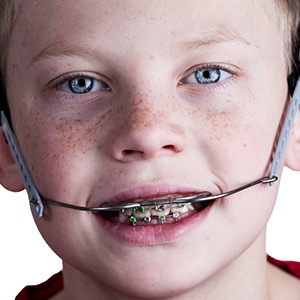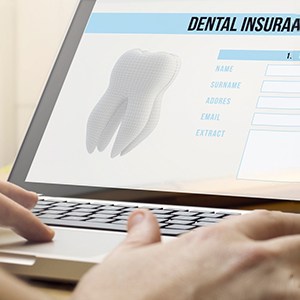Dentofacial Orthopedics – Plano, TX
No Need For Invasive
Bite Correction Surgeries
Dr. Jones and Dr. Amerson are able to do much more than align your teeth at Willow Bend Orthodontics of Plano, they're also able to fix the root problems of those issues by addressing the underlying bone that supports those teeth as well. Dentofacial orthopedics allow our team to correct severely misaligned bites without the need for invasive surgeries that have lofty recovery times. In addition to improving the overall function of your smile, we’re also able to make the face appear fuller and more symmetrical. To find out more about dentofacial orthopedics in Plano, TX, schedule a free consultation with us today!
Why Choose Willow Bend Orthodontics of Plano
for Dentofacial Orthopedics?
- Non-Invasive Alternative to Corrective Jaw Surgery
- Board-Certified Orthodontist with 16 Years of Experience
-
Family-Owned &
Operated Orthodontic Office
What is Dentofacial Orthopedics?

Although the name “dentofacial orthopedics” makes it seem like a complicated process, it’s actually simple. If the supporting top and bottom jaw bones aren’t in the proper position, the bite will never be aligned. Dentofacial orthopedics addresses this underlying issue by stimulating growth in one of the jawbones so the bite will come together, aligned. This treatment also offers many aesthetic issues as well, such as the pronounced appearance of an overbite or underbite. It’s also less invasive and can erase the need for surgical procedures.
Understanding the Cost of Dentofacial Orthopedics

The cost of dentofacial orthopedics varies from case to case. During your free consultation, our team will provide you with a personalized price estimate. Overall treatment costs for orthodontia combined with dentofacial orthopedics typically amount to several thousand dollars. We recognize that many patients are working with a tight budget, so we will do all we can to help you afford your care.
Factors That Affect the Cost of Dentofacial Orthopedics

Some of the factors that can influence the cost of dentofacial orthopedics include:
- The type of dentofacial orthopedic appliance that is needed. Dentofacial orthopedics can involve the use of a number of different devices, some of which cost more than others. The materials used and the manufacturer of the devices can also influence price.
- The treatment timeline. Complex orthopedic problems necessitate a longer overall treatment timeline and a higher number of appointments with our team. Therefore, greater fees are to be expected. If you do not comply with treatment instructions, you might end up extending your treatment even further and incurring higher costs.
- Your age. Dentofacial orthopedics is usually most effective for children since their facial bones are still developing. Adult cases are more complex. You might need surgery along with your orthopedic devices. Surgery comes with its own fee that can be quite significant.
Does Dental Insurance Cover Dentofacial Orthopedics?

Dental insurance companies take vastly different approaches to dentofacial orthopedics. Some might limit their coverage to minors (patients under 18 or 21), whereas a handful of premium plans may cover adult treatment as well. Your coverage rate may depend on the type of appliance you need and other factors.
Our team members are experienced experts when it comes to dealing with dental insurance. You can rely on us to help you maximize your benefits. We are even in-network with several popular policies. If your plan includes coverage for dentofacial orthopedics, we will do all we can to minimize your out-of-pocket costs.
Options for Making Dentofacial Orthopedics Affordable

We do not want you to worry too much about being able to afford your care. That is why we do more than just help you file insurance claims. We offer a few additional provisions that might make it easier for you to find a place in your budget for dentofacial orthopedics:
- A complimentary consultation. You can take the first step on your orthodontic/orthopedic journey for FREE.
- Financing. Willow Bend Orthodontics proudly offers in-house financing. Ask our team about how you can take advantage of it. If your application is approved, you will be able to pay for your treatment over time in manageable monthly installments.
Dentofacial orthopedics may cost a significant amount of money. However, you should not let financial concerns holding you back from undergoing necessary care. Get in touch with our Plano office today to learn more about we may be able to help you afford a healthier smile.
Dentofacial Orthopedics FAQs

You only want the best for your child’s long-term oral health, which is why having them undergo dentofacial orthopedics can be extremely beneficial for their smile. If you’re unfamiliar with how treatment works or you want to help your child feel as confident about their care as possible, we understand that you may have questions. Please take a moment to look over some of the most common questions we hear below, as well as our detailed responses. If you have other concerns in mind, please let us know at your next appointment.
How long does treatment using dentofacial orthopedics take?
It’s important to keep in mind that the length of treatment largely depends on the individual patient as every smile responds differently. Furthermore, if your child has more substantial complications that require attention, their treatment will take longer on average. With that said, you can expect your child’s orthopedic care to take anywhere between 6 and 30 months, with the average treatment taking about 22 months. We’ll break down a detailed timeline with you directly so you know exactly how to stay on track.
What’s the difference between orthodontic and orthopedic?
Many people assume that orthodontic and orthopedic mean the same thing, but they are actually quite different. While orthodontic treatment refers specifically to movement of teeth to address misalignment, orthopedic treatment refers to improving the skeletal structure of your child’s face and jaw. In cases like these, treatments like braces are not ideal for fixing these complex dental issues. We’ll speak with you and your child directly to determine the best treatment options based on their needs.
What appliances are used for dentofacial orthopedics?
There are many orthopedic appliances out there today designed to change the rate, direction, or amount of jaw growth that occurs. While some are more common others, the options we may recommend include the following:
- Palate expander – Slowly pushes cartilage above the upper jaw apart and widens the maxilla
- Lower jaw expander – Gradually moves teeth apart to provide additional room
- Activators – Moves the upper and lower jaws forward while guiding erupting teeth
- Block – Uses the bite force to move teeth and correct malocclusions gradually and comfortably
- Orthodontic headgear – Appliance that straps around the face, applies forces to the jaw and head, and corrects bite problems that can’t be resolved from inside the mouth
Does my child need dentofacial orthopedics?
Children should receive an orthodontic evaluation by the age of 7 so that our team has time to prepare for their most dramatic dental development that’s just around the corner. In fact, significant growth typically begins between the ages of 9 and 11. This makes it the most ideal time to begin dentofacial orthopedic therapy. During your child’s consultation, we’ll be able to determine if treatment can help them address specific complications. Notable signs your child may need treatment include if they have overcrowded or overlapping teeth, they lose baby teeth early, or they have a noticeable overbite.

